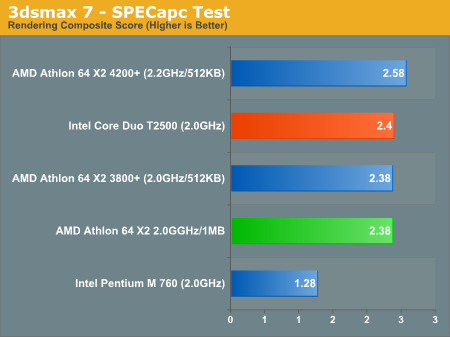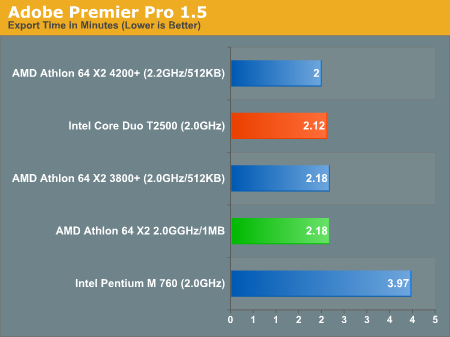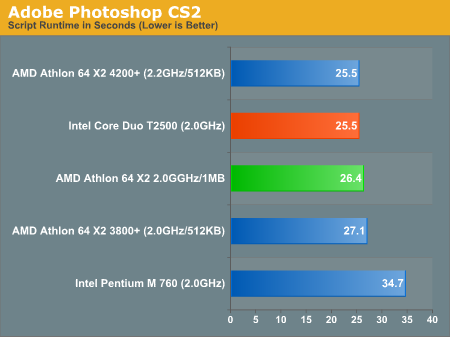Intel Core Duo (Yonah) Performance Preview - Part II
by Anand Lal Shimpi on December 19, 2005 12:55 PM EST- Posted in
- CPUs
Professional Application Performance with 3dsmax, Adobe Premier and Photoshop
We start off our page on professional application performance with an updated version of the SPECapc 3dsmax test, updated for version 7 of the application. The scenes being rendered haven't actually changed, but the reference numbers used to compute the composite scores have, so these scores aren't directly comparable to results from earlier SPECapc tests.
Compared to the Athlon 64 X2, the Core Duo comes out on top, but by a very small margin - once again we're faced with a virtual tie.
The breakdown of the rendering composite score can be found below; the scores in the table are render time in seconds, lower numbers are better:
Moving onto Adobe Premier Pro 1.5, this test is actually one that is used by Intel to showcase the performance of the Pentium 4 processor. With the Pentium 4 absent from this comparison, we were curious as to how it compared to the Core Duo and the Pentium M.
As with virtually any media encoding performance, dual-core processors do extremely well, and this case is no different with the Core Duo T2500 seriously outpacing the Pentium M 760.
The Core Duo T2500 is also able to complete the export process in about 97% of the time of the Athlon 64 X2, which once again ends up being borderline negligible for this test, but it is important to note that this advantage comes without the aid of an on-die memory controller.
Our final test is the only other Intel-supplied test in the suite. This one used to showcase the Pentium 4's performance under Adobe Photoshop CS2 by measuring the time that it takes to run a few filters and resize/export images. The script itself is fairly realistic; however, with Photoshop filters, it is easy to favor one architecture over another, so by no means are these numbers intended to be conclusive of Photoshop CS2 performance.
We start off our page on professional application performance with an updated version of the SPECapc 3dsmax test, updated for version 7 of the application. The scenes being rendered haven't actually changed, but the reference numbers used to compute the composite scores have, so these scores aren't directly comparable to results from earlier SPECapc tests.

Compared to the Athlon 64 X2, the Core Duo comes out on top, but by a very small margin - once again we're faced with a virtual tie.
The breakdown of the rendering composite score can be found below; the scores in the table are render time in seconds, lower numbers are better:
| SPECapc 3dsmax 7 Breakdown | AMD Athlon 64 X2 4200+ | AMD Athlon 64 X2 3800+ | AMD Athlon 64 X2 2.0GHz/1MB | Intel Core Duo T2500 | Intel Pentium M 760 |
| 3dsmax 5 rays | 15.406 | 15.829 | 16.109 | 14.297 | 25.246 |
| CBALLS2 | 20.125 | 22.281 | 22.094 | 21.187 | 42.201 |
| SinglePipe2 | 92.844 | 101.906 | 101.922 | 107.359 | 203.492 |
| UnderWater | 142.938 | 157.219 | 156.203 | 169.188 | 316.055 |
Moving onto Adobe Premier Pro 1.5, this test is actually one that is used by Intel to showcase the performance of the Pentium 4 processor. With the Pentium 4 absent from this comparison, we were curious as to how it compared to the Core Duo and the Pentium M.

As with virtually any media encoding performance, dual-core processors do extremely well, and this case is no different with the Core Duo T2500 seriously outpacing the Pentium M 760.
The Core Duo T2500 is also able to complete the export process in about 97% of the time of the Athlon 64 X2, which once again ends up being borderline negligible for this test, but it is important to note that this advantage comes without the aid of an on-die memory controller.
Our final test is the only other Intel-supplied test in the suite. This one used to showcase the Pentium 4's performance under Adobe Photoshop CS2 by measuring the time that it takes to run a few filters and resize/export images. The script itself is fairly realistic; however, with Photoshop filters, it is easy to favor one architecture over another, so by no means are these numbers intended to be conclusive of Photoshop CS2 performance.

Overall System Performance using WorldBench 5
Media Encoding Performance with DVD Shrink, WME, Quicktime and iTunes










103 Comments
View All Comments
ncage - Monday, December 19, 2005 - link
I swear this is the best first post ive ever seen. Good Post Alex. Ya competition is very good for the market. I think intel is starting to get back on track where they need to be. It all comes down to clock speed and cost at launch. What improvements will we see with the launch of amd's next chip other than ddr2 which right now i don't really care about and possibly more cores (at least for the opteron). I am not dogging amd because for about 3-4 years ive only used AMD chips but i think amd has to raise the bar even more.Calin - Tuesday, December 20, 2005 - link
DDR2 for AMD would be great at least for a few things:moving to single channel DDR2 memory would decrease costs (in mainboards and a bit in processors)
moving integrated graphics to single or dual channel DDR2 would increase graphic performance and overall system performance in relation to single or dual channel DDR
As for the high end, I really don't think an increase in memory bandwidth will help - not even for dual core processors. Maybe for a quad core, but quad cores are certainly for servers, and I don't know about registered DDR2 memory to be used in them.
Hmmm, you could try an Opteron Dual Core with single channel DDR memory, to see how much performance would be lost by going quad core, dual DDR.
mlittl3 - Monday, December 19, 2005 - link
I agree with both Alex and ncage. I really disliked Intel all through out the Pentium4/Net-burst days. They were just releasing marchitecture with no improvements whatsoever. I loved AMD for their innovation and performance/watt.Now both companies are equal but I don't think we will see the huge fall AMD suffered from when Intel released the Pentium 4 to compete with the Athlon/K7 architecture. The beauty of competition is showing its bright colors right now. If we only had Intel, we would have a very hot/power consuming inefficient Pentium 4 based on net-burst to play Quake 4 at 5fps right now.
Its time for the fanboys to turnover a new leaf. Go Intel and AMD!!! We love both you guys.